#Robotic process automation
Text
Unlocking Efficiency and Innovation: The Role of Robotic Process Automation (RPA)
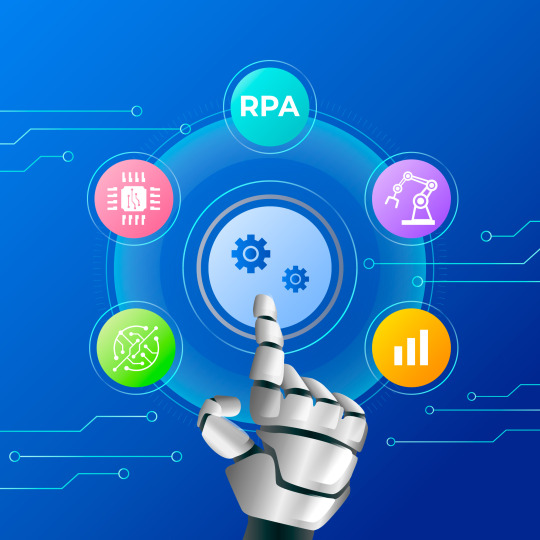
In today's fast-paced and competitive business environment, organizations are constantly seeking ways to improve efficiency, reduce costs, and increase productivity. Robotic Process Automation (RPA) has emerged as a powerful tool that can help businesses achieve these objectives.
What is Robotic Process Automation (RPA)?
Robotic Process Automation (RPA) is a technology that allows businesses to automate repetitive, rule-based tasks. It uses software robots, also known as "bots," to mimic human actions and interact with digital systems. These bots can log into applications, navigate through screens, input data, and complete tasks just like humans would.
The Role of RPA in Business:
RPA can be used to automate a wide range of tasks across various industries and departments. Here are some examples:
Finance and Accounting: Automating tasks such as accounts payable and receivable, invoice processing, and financial reporting.
Customer Service: Automating tasks such as answering FAQs, resolving customer inquiries, and processing orders.
Human Resources: Automating tasks such as onboarding new employees, processing payroll, and managing benefits.
IT: Automating tasks such as provisioning accounts, managing user access, and deploying software updates.
Impact of RPA on Businesses:
Implementing RPA can offer numerous benefits to businesses, including:
Increased efficiency and productivity: RPA can automate time-consuming and tedious tasks, freeing up employees to focus on more strategic and value-added activities.
Reduced costs: RPA can help businesses save money on labor costs, as well as reduce errors and compliance risks.
Improved accuracy and compliance: RPA bots are programmed to follow specific rules and procedures, which can help to improve accuracy and compliance with regulations.
Enhanced process visibility and control: RPA provides businesses with a clear view of their processes, which can help them identify and address bottlenecks.
Improved customer satisfaction: RPA can help businesses improve customer satisfaction by automating tasks such as order processing and customer service interactions.
RPA Services:
Implementing RPA successfully requires a partner with expertise in the technology and a deep understanding of business processes. A comprehensive RPA solution should include the following services:
Document AS-IS Process: This involves mapping out the existing process to identify areas for automation.
Design & Development of Bots, workflows, and forms for process automation: This includes designing and developing the software robots that will automate the tasks.
Bot license (We will use the appropriate underlying technology): This provides access to the software robots and the underlying technology platform.
Infrastructure: This includes setting up the necessary infrastructure to support the Robotic Process Automation (RPA) solution.
Production Deployment of the Bots: This involves deploying the bots to production and monitoring their performance.
RPA support: This includes ongoing support for the RPA solution, such as troubleshooting and maintenance.
Test & Deploy bots to production: This involves testing the bots in a production environment and making any necessary adjustments before they are deployed to full production.
Configuration data changes: This involves making changes to the configuration data of the bots as needed.
Password updates: This involves updating the passwords of the bots as needed.
Errors in executing the Bots: This involves resolving errors that occur during the execution of the bots.
Determining the “root cause” of a recurring issue or incident & recommendations: This involves identifying the root cause of a recurring issue or incident and recommending solutions to prevent it from happening again.
Infrastructure/application related issues: This involves resolving issues with the infrastructure or applications that the bots are interacting with.
Conclusion:
RPA is a powerful technology that can have a significant impact on businesses of all sizes. By automating repetitive tasks, RPA can help businesses improve efficiency, reduce costs, and increase productivity. However, it is important to choose a reputable Robotic Process Automation (RPA) companies with the expertise and experience to help you implement a successful RPA solution.
Ready to embrace the power of RPA?
Contact us today to learn more about how RPA can help your business achieve its goals.
#robotic process automation#robotic process automation rpa#rpa automation#robotic process automation software#rpa software#robotic process automation companies#robotic process automation technology#robotic process automation in healthcare#robotic process automation in banking#rpa solution#robotic process automation for finance#process automation solution#robotic process automation services#robotic process automation for insurance#rpa system#what is rpa automation#robotic process automation solution#robotic process automation benefits#robotic process automation consulting#robotic process automation consultant#rpa service provider#rpa consulting services
2 notes
·
View notes
Text
Optimierung der Reaktionszeiten durch gezielte Automatisierung
In einer zunehmend dynamischen Geschäftswelt ist die Geschwindigkeit, mit der Unternehmen auf Veränderungen und Herausforderungen reagieren, von entscheidender Bedeutung. Die Optimierung der Reaktionszeiten durch gezielte Automatisierung stellt eine Schlüsselstrategie dar, um die Effizienz und Wettbewerbsfähigkeit zu erhöhen. In diesem Artikel werden wir untersuchen, wie durch effektive…
#Automatisierte Kommunikation#Automatisierung#Automatisierungslösungen#Change Management#Chatbots#Effizienzsteigerung#Geschäftsprozesse#Kundenzufriedenheit#Robotic Process Automation#Robotic Process Automation (RPA)#RPA
0 notes
Text

Robotic Process Automation: Revolutionize Efficiency with RPA Solutions
Discover how Robotic Process Automation (RPA) can revolutionize efficiency by automating repetitive tasks, reducing human error, and improving business productivity. Explore cutting-edge RPA solutions for streamlined operations and cost savings.
0 notes
Text
Top Robotic Process Automation (RPA) Courses Online

As businesses continue to strive for efficiency & innovation, Robotic Process Automation (RPA) has emerged as a game changer in streamlining operations & reducing repetitive tasks. For professionals looking to leverage RPA technologies, obtaining a solid understanding & certification is crucial.
This guide explores the best RPA courses available online to help you become proficient in RPA & advance your career. Let us dive into the top options available, starting with igmGuru & explore their offerings in detail.
igmGuru: Leading the RPA Training Charge
igmGuru stands out as a premier provider of RPA course, offering comprehensive training that caters to both beginners & seasoned professionals. Their RPA certification program is designed to provide an in depth understanding of automation technologies, including process mapping, automation design & implementation. The course covers leading RPA tools such as UiPath, Blue Prism & Automation Anywhere, equipping learners with the skills needed to excel in the field.
igmGuru s RPA online training is highly praised for its practical approach, featuring real world case studies & hands on exercises. This ensures that students not only learn theoretical concepts but also gain valuable experience in applying RPA solutions. Additionally, the course includes personalized support & guidance from industry experts, which helps in addressing any queries & providing additional insights.
Udemy: Flexible Learning for Busy Professionals
Udemy offers a wide range of RPA courses, making it a versatile choice for those looking to balance their studies with other commitments. One of the most popular RPA courses on Udemy is the "Robotic Process Automation (RPA) – Automation Anywhere" course. This course focuses on Automation Anywhere, one of the leading RPA platforms & covers topics such as automation development, workflow design & bot management.
Udemy s RPA online courses are known for their flexibility & affordability. The platform allows learners to access course materials at their own pace, which is ideal for busy professionals. Furthermore, Udemy provides lifetime access to course content, so you can revisit lessons & refresh your knowledge whenever needed.
Coursera: University Backed RPA Courses
For those seeking a more academic approach, Coursera offers RPA courses backed by top universities & institutions. One notable option is the "Robotic Process Automation (RPA) Beginner to Advanced" course provided by the University of London. This course covers the fundamentals of RPA & advances to more complex topics, including RPA strategy & implementation.
Coursera is RPA online courses that come with the added benefit of earning a certificate from a prestigious institution, which can enhance your resume & open doors to new career opportunities. Additionally, Coursera offers a structured learning path with assessments & peer reviews to help solidify your understanding.
LinkedIn Learning: Professional Development for RPA
LinkedIn Learning, formerly known as Lynda.com, provides a range of RPA training courses aimed at professional development. The "Learning Robotic Process Automation" course is a great starting point for those new to RPA. It covers the basics of RPA technology, its benefits & practical applications.
LinkedIn Learning s RPA courses are integrated with their professional network, allowing learners to connect with industry experts & peers. The platform also offers personalized course recommendations based on your career interests & goals, making it easier to find relevant RPA training that aligns with your professional aspirations.
Simplilearn: Comprehensive RPA Certification Programs
Simplilearn offers specialized RPA certification programs designed for those who want to achieve a professional RPA certification. The "RPA Certification Training" course includes training on popular RPA tools such as UiPath & Blue Prism & covers key aspects of RPA implementation & management.
Simplilearn is RPA courses structured to provide both theoretical knowledge & practical skills. The program includes interactive sessions, real world projects & mock exams to prepare you for the certification exam. Simplilearn is known for its rigorous training approach & high quality resources, which can significantly boost your chances of obtaining an RPA certification.
EdX: High Quality RPA Courses from Top Institutions
EdX provides RPA training from some of the world is leading institutions, including MIT & Harvard. The "Introduction to Robotic Process Automation" course, for instance, offers a comprehensive overview of RPA technologies & their applications in business settings.
EdX s RPA online courses are designed to offer a deep understanding of RPA principles & practices. The platform also provides verified certificates that can enhance your professional profile & demonstrate your expertise to potential employers.
Culmination
Robotic Process Automation is transforming the way businesses operate & acquiring RPA skills through online courses is a strategic move for career advancement. Whether you are just starting or looking to deepen your expertise, the courses offer a range of options to suit different learning styles & professional goals.
By choosing the right RPA course that fits your needs & goals, you can enhance your skills, earn valuable certifications & position yourself for success in the rapidly evolving field of RPA.
0 notes
Text

Fueling innovation with risk and compliance driven end-to-end automation
Explore Nasdaq's approach to innovation, leveraging risk and compliance-driven end-to-end automation to streamline processes and maintain regulatory standards.
0 notes
Text

Understand the difference: Process Automation streamlines entire operations with IT resources, while RPA focuses on automating specific, repetitive tasks with easy-to-use bots. Choose the right solution to boost efficiency.
Switch to Botgo now! 🌐 Visit Us: https://botgo.io for a free 60-day trial, demo, and quotes!
0 notes
Text
AutomationTwin

Experience the future of automation with TFT's AutomationTwin. Our platform leverages Robotic Process Automation (RPA) to enhance efficiency and accuracy. By mirroring human actions, AutomationTwin RPA Software Solutions automates tasks seamlessly, optimizing workflows and cutting costs while ensuring near-zero error rates and 24/7 operation.
1 note
·
View note
Text
Produktivitätssteigerung durch Automatisierung: Ein Leitfaden
In einer zunehmend digitalisierten Welt ist die Automatisierung von Prozessen eine der effektivsten Methoden zur Steigerung der Produktivität in Unternehmen. Durch den Einsatz modernster Technologien können ineffiziente Arbeitsabläufe optimiert und repetitive Aufgaben automatisiert werden. In diesem Artikel beleuchten wir die Grundlagen der Automatisierung zur Produktivitätssteigerung sowie…
#Automatisierte Prozesse#Automatisierung#Automatisierungslösungen#Effizienzsteigerung#Führung#Künstliche Intelligenz#Machine Learning#Robotic Process Automation#Robotic Process Automation (RPA)#RPA
0 notes
Text
The ultimate platform for all your RPA solutions!
Run and manage your bots with custom forms and interact with them WITHOUT LICENSE COSTS.
#RPA #UiPath #Robot #Automation
@uipath
1 note
·
View note
Text
Embracing the Future: Enhancing Customer Experience with Digital-First Customer Service Solutions
In recent years, digital technologies such as artificial intelligence (AI), machine learning (ML), and robotic process automation (RPA) have profoundly reshaped organizational culture and customer experience. These advancements have driven a significant shift in customer expectations, giving rise to an always-connected buyer who demands relevant content on any device and at any time.…
#AI in customer service#Customer Engagement Solution#Customer Experience#CX#Digital Transformation#Digital-first customer service#first digital card customer service#first digital customer service#Machine Learning#robotic process automation
0 notes
Text
How RPA Optimized Workflows in Cyber Security Operations

Has technology been a fortress or a battlefield for you in this digital age? At an individual level, technology is a blessing in ignorance. However, at the enterprise software solutions development level, technology has proven to be a two-edged sword.
One in three Americans has faced a cyberattack in the last 12 months. Research data shows that over 5.6 billion data records were breached by cyber threats in 2023, and the average cost of a data breach was $4.24 million, a 15% rise compared to 2022. The damage of $6 trillion should awaken cybersecurity professionals.
Synopsis
Therefore, this blog delves deep into the potential of cyber threats and data breaches and how emerging technologies such as robotic process automation and artificial intelligence can thwart massive financial losses caused by cyber-attacks. At the roots, we will explore the synergy between RPA and cybersecurity and the promising prospects of RPA in cybersecurity.
Global Cyber Threat Landscape
In 2024, sensitive financial information and individual identities will face unprecedented threats from cybercriminals. With technological advancement, the threat perception is growing daily. Not only individuals and businesses but also governments are at risk of losing sensitive information to criminals who can misuse it for money, disrepute businesses, or even for terrorism.
Ransomware: Hackers encrypt software and lock users out of their systems. They demand money to unlock their systems and data. In 2022, there was a 13% increase in ransomware attacks, amounting to an average of a little less than a million dollars.
Phishing: Fake emails are sent as legitimate ones to trick users into revealing their financial information and personal details to siphon off money from their bank accounts or send authentic mail for money. 76% of businesses faced phishing challenges in 2023.
Data Breaches: Small and medium enterprises cannot afford heavy security, and hackers exploit these vulnerabilities to gain access to their data and steal information. In 2023, the average cost of the data breach was $4.45 million, 15% up from 2022.
DDoS Attacks: Hackers go berserk about attacking a website or system, denying the business the ability to utilize services and causing massive damage to data and the entire system. 2022 witnessed over 10 million DDoS attacks on businesses, disrupting online services severely.
Supply chain attacks: When a custom software development company does not provide enough security, hackers enter the business system through code manipulation and update it with malicious or fake code to disrupt services for millions of users, bringing disrepute to businesses.
Social Engineering: In today’s digital world, manipulating humans psychologically is not difficult. Hackers go to any extent and torture people online to gain unauthorized access to their personal information, which can be used to hide criminal activities or money laundering.
What is RPA in Cybersecurity?
Imagine a team of cybersecurity experts protecting IT infrastructure, applications, and data 24/7 without asking for food or sleep. Yes, that’s what robotic process automation offers.
RPA service providers develop software bots with predefined tasks, workflows, and rules to automate repetitive tasks related to cybersecurity. The advantage of these RPA bots is they work at lightning speed and process data in real-time and accurately, red-flagging potential cyber threats.
Moreover, RPA solutions reduce human errors, which, according to the Ponemon Institute, are one of the main reasons for vulnerability. Human errors expose 60% of businesses to cyber threats.
Why RPA Matters in Cybersecurity?
Efficiency, accuracy, speed, and reliability are the fundamentals of RPA in cybersecurity. Robotic process automation takes the burden off cybersecurity experts by performing mundane tasks, evaluating threat perception, and responding to threats with disaster mechanisms. For businesses, RPA for cybersecurity is a long-term investment as the average cost of a data breach grows every year.
Quick detection: RPA bots analyze massive data in real-time with infallible accuracy to prevent 60% of the threats at the initial levels.
Improved response: Rule-based RPA bots reduce response time from 67 minutes to 29 minutes because of automated workflows.
Compliance: RPA solutions are designed to meet all international data privacy regulations, reducing 92% of compliance-related errors.
Cost-effective: process automation development helps businesses save 40% of operational costs annually, ensuring strategic allocation.
Resource allocation: RPA in cybersecurity takes over routine tasks, freeing 50% of the security team’s time for more strategic tasks.
Reduced error: Since RPA removes humans from equations, it automatically facilit ates an error-free system by reducing errors by 80%.
How does RPA optimize workflows in cyber security operations?
Having a business process in a particular sequence in a disciplined manner not only saves a lot of money but also reduces human errors, taking overall operational efficiency to over 80%. Workflow automation prevents businesses from cyber attacks by tracking systems 24/7, analyzing system logs, and scanning the entire system for loopholes.
Studies speak for the effectiveness of RPA in cybersecurity. Businesses have witnessed 70% less burden on humans due to implementing RPA, which improves cyber threat detection by 25%. Businesses leveraging RPA to stay ahead of threat perception and emerging threats.
Log Management: RPA bots automatically scroll through mountains of logs and analyze them quickly. They highlight anomalies and reduce manual review time by 80%.
Scan and Patch: RPA bots scan the system for vulnerabilities in real-time and apply security patches, ensuring complete protection. Subsequently, they conduct deep analysis.
Threat Detection: RPA bots rely on predefined rules to monitor the system 24/7 and identify security threats. This improves the speed of cyber threat detection by 25%.
Incident Response: The RPA bot’s job is to lock out accounts, alert humans, contain the damage, and collect evidence in the event of a security breach or cyber attack.
User Provisioning: RPA solutions manage user access and automate user control based on business policy. They allow only authorized access and prevent illegitimate access.
Compliance Reporting: RPA prepares security reports automatically and quickly submits them to compliance authorities. It reduces compliance reporting time by 70% and limits errors.
Vulnerability Management: RPA bots identify weaknesses in the system and prioritize repair. It can check over a million data points each day to improve overall security.
Phishing Email Triage: RPA solutions are designed to scan each email for cyber threats. They automatically isolate threats and take down 60% of phishing-related events.
Backup and Recovery: RPA bots regularly create data backups to ensure the system remains intact during cyber attacks. It helps reduce recovery time by 50 per cent.
Overcoming Challenges in Implementing RPA for Cybersecurity
Robotic process automation may be an emerging technology with numerous benefits, but implementing and integrating RPA bots into the existing system can be challenging. Moreover, quality RPA solution development can initially consume time and money.
A study in 2023 found that 67% of businesses struggled with efficient RPA implementation. If you collaborate with a technology partner experienced in developing enterprise software solutions, you can easily overcome these RPA implementation challenges with effective RPA strategy and precise execution.
Businesses need to ensure that the RPA solution is fully secure against cyber threats.
Integrating RPA solutions to existing traditional systems requires technology upgrades.
However automated, human oversight is required over RPA solutions against dependency.
Businesses need to be ready to manage the initial cost of RPA solutions and their integration.
RPA should be compliance-ready and must be designed to automate the compliance process.
Businesses need in-house expertise to maintain the RPA solution and fix it if necessary.
Maintaining human-machine balance for security needs requires a critical strategy.
Keep RPA scripts updated and workflow streamlined for maximum performance.
Considerations for RPA Implementation in Cybersecurity
Whenever a technology upgrade is required, businesses need a strategy from a technology consultant. To determine which solution is suitable for each pain point, it is necessary to identify the pain points and their causes.
Critical considerations, from budget to resource allocation, should be addressed before RPA implementation. A 2023 study revealed that businesses that strategically implement RPA have gained a 40% increase in operational efficiency. Consider these 8 points for excellent RPA solution implementation.
Identify the security process and workflows that suit your business.
Evaluate the scope of automation across business pain points.
Determine the proper process automation solution or its combination.
Analyze the return on investment of the RPA solution and implementation.
Develop a detailed change-management strategy for employees.
Compare existing security apparatus against futuristic RPA cybersecurity.
Set processes for RPA operation governance and human oversights.
Deploy highly secure tools to protect RPA bots from cyber threats.
Ensure compliance with relevant industry standards and regulations.
Develop metrics to measure the performance of RPA in cybersecurity.
Conclusion:
Let us summarize the impact of robotic process automation on cybersecurity by suggesting that this is a game changer when combined with predictive analysis of artificial intelligence. These rule-based RPA bots are going to change the way businesses protect their data and applications.
Implementing RPA has its own set of challenges, but businesses can reap the rich benefits of RPA solutions if implemented accurately. From securing vulnerable networks to disaster recovery, RPA proves to be the valuable digital asset of the future.
Always stay a step ahead of the emerging threats by adopting RPA in cybersecurity.
Original source: here
0 notes
Text
Microsoft Power Automate Leading the Way in Hyperautomation
Introduction
The evolution of automation technology has been nothing short of revolutionary, reshaping the way businesses operate and empowering organizations to streamline processes, boost productivity, and drive innovation. Among the pioneers in this digital transformation journey stands Microsoft Power Automate, a platform that has emerged as a catalyst for change in the realm of workflow automation and desktop automation. Starting from its modest origins and progressing to become a formidable force in hyper automation, Power Automate has consistently adjusted and grown to incorporate the most recent trends and breakthroughs in artificial intelligence (AI).
In this article, we’ll delve into the origins of Microsoft Power Automate, tracing its journey from conception to its pivotal role in today’s era of hyper automation. We’ll explore how Power Automate has embraced AI advances to empower users with intelligent automation capabilities, enabling them to tackle complex tasks with ease and efficiency.
What is Power Automate and how did it emerge?
Softomotive, now part of Microsoft Power Automate, was a leading robotic process automation (RPA) software company founded in 2005. The company offered RPA solutions such as Win Automation and Process Robot, focusing on making automation accessible to a wide range of users. In May 2020, Microsoft acquired Softomotive to strengthen its RPA capabilities and integrate them into the Power Automate platform. This acquisition expanded Power Automate’s offerings with desktop automation tools and furthered Microsoft’s commitment to automation in both attended and unattended scenarios. Softomotive’s integration into Microsoft Power Automate has played a significant role in shaping the automation landscape, aligning RPA with Microsoft’s suite of productivity and cloud services.
Power Automate is a cloud-based service that allows users to create and run automated workflows across various applications and services. It was launched by Microsoft in 2016 as Microsoft Flow and rebranded as Power Automate in 2019. Power Automate is part of the Microsoft Power Platform, which also includes Power Apps, Power BI, and Power Virtual Agents.
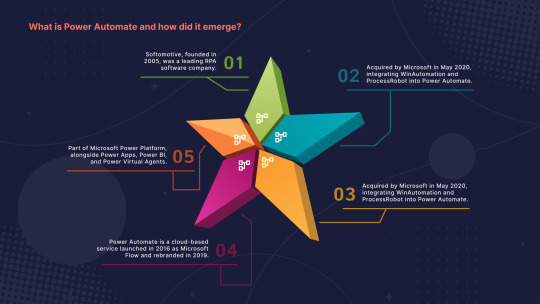
What are some of the challenges faced in RPA CoEs and Power Automate addresses these?
While Power Automate offers significant advantages. It aims to democratize automation and empower users to automate their everyday tasks without coding. It offers a low-code graphical interface, as well as a code-first approach for advanced users. Power Automate also supports Robotic Process Automation (RPA), which enables users to automate repetitive and rule-based tasks that involve legacy systems and desktop applications.
Despite the advantages, RPA Centers of Excellence (CoEs) need to be prepared for a unique set of challenges and considerations when their support teams use this platform.
Challenges anticipated by Power Automate Users:
Power Automate Desktop has yet to match the extensive capabilities of Automation Anywhere, Blue Prism and UiPath.
Governance poses a challenge due to the less mature orchestration layer.
Clarity regarding licensing remains a concern for customers.
How has RPA Adoption Landscape changed in the past 5 years?
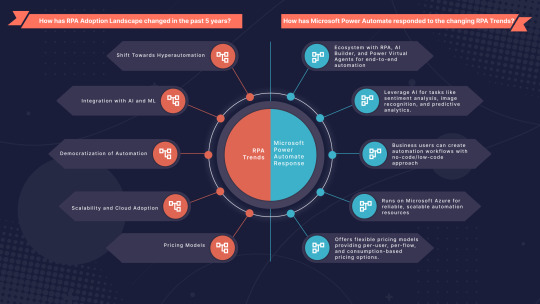
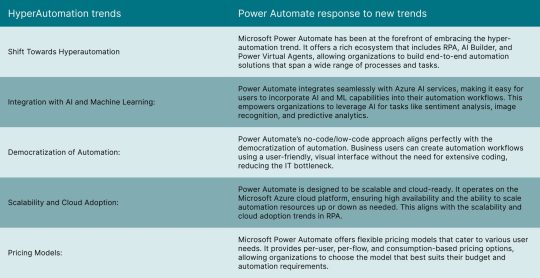
What should the RPA CoEs look out for while adopting Power Automate?
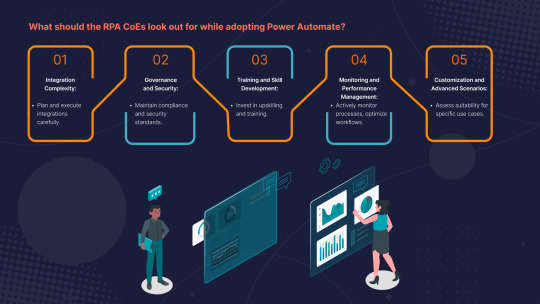
While Microsoft Power Automate offers numerous advantages, RPA CoEs should be prepared for the following challenges and considerations:
Integration Complexity: Integrating Power Automate with existing systems and applications may be complex in certain scenarios. RPA CoEs need to carefully plan and execute integrations to ensure seamless data flow and process automation.
Governance and Security: Maintaining governance and security standards is crucial. RPA CoEs must ensure that automation workflows adhere to compliance requirements and data security protocols, especially when handling sensitive information.
Training and Skill Development: Transitioning to Power Automate may require upskilling and training for support teams. CoEs should invest in training resources and knowledge-sharing to empower support teams to make the most of the platform.
Monitoring and Performance Management: Power Automate provides monitoring and performance management tools, but RPA CoEs need to actively monitor automation processes, identify bottlenecks, and optimize workflows for efficiency.
Customization and Advanced Scenarios: Handling highly customized or advanced automation scenarios may require custom code or more advanced RPA platforms. CoEs should assess the suitability of Power Automate for specific use cases.
What are the facts and predictions of Microsoft's future plans with Power Automate success in upcoming years?
Microsoft has been investing heavily in Power Automate and its RPA capabilities, and has achieved significant success and recognition in the market. Some of the facts and predictions of Microsoft’s future plans with Power Automate success in upcoming years are:
According to Microsoft, Power Automate has over 200,000 customers and 10 million monthly active users, and has processed over 3 billion flows per month
According to Gartner, Microsoft is a leader in the 2020 Magic Quadrant for Enterprise Low-Code Application Platforms, and a visionary in the 2020 Magic Quadrant for Robotic Process Automation Software
According to Forrester, Microsoft is a leader in the 2020 Wave for Digital Process Automation for Wide Deployments, and a strong performer in the 2020 Wave for Robotic Process Automation
Microsoft plans to continue to expand and improve Power Automate and its RPA features, by adding more connectors, AI models, templates, and integrations with other Microsoft products and services
Microsoft also plans to leverage its cloud, AI, and security capabilities to enable more scalable, intelligent, and secure RPA solutions for its customers
Microsoft envisions Power Automate as a key component of its digital transformation strategy, and as a platform that can empower every person and every organization to automate their workflows and processes
Conclusion
Microsoft Power Automate has demonstrated its commitment to adapting to the recent trends in Hyper Automation and AI space and offers significant advantages for RPA CoEs. However, CoEs should be prepared for integration complexities, governance and security challenges, training and skill development needs, monitoring and performance management responsibilities, and considerations for highly customized scenarios. By addressing these challenges proactively, RPA CoEs can leverage Power Automate to empower their support teams and thrive in the era of hyperautomation, benefiting both business users and support teams.
Radium AI, a digital workforce management platform powered by Machine Learning capabilities, is revolutionizing the industry. This innovative product seamlessly integrates with major RPA platforms like UIPath, Blue Prism and Automation Anywhere, with its ongoing integration with Power Platform. Offering real-time monitoring, it serves as a centralized hub for support teams engaged in Digital Worker Management. Additionally, Radium AI boasts an array of features, such as an embedded Advanced Analytics platform and a Low-code Workflow designer for crafting new orchestrations.
To Explore Radium AI Further And Schedule A Demo At Your Convenience, Please Utilize The Link:
Schedule A Demo
1 note
·
View note
Text
1 note
·
View note